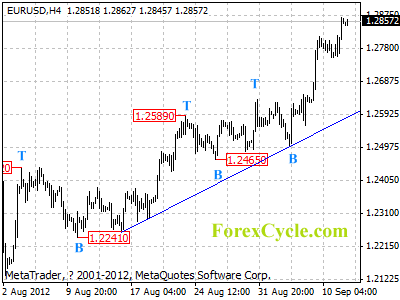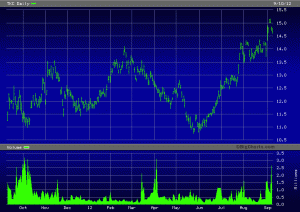For some reason, the resource sector likes to run with one new ‘hot commodity’ each year.
Back in 2009, lithium was the big new thing. Then in 2010, the rare earths bandwagon stole the spotlight.
In 2011 it was potash, and this year it has been graphite.
But a few years on, the lithium story has matured and is back in the spotlight for serious investors…
For one thing, lithium prices are on the march back up again. The world’s biggest producers, who all but control the market, have just increased their prices for lithium carbonate by around 20%.
The reason is that demand is rising strongly again. Lithium is an essential component of lithium ion batteries, which is what runs your mobile phone, iPad or laptop computer. Electric vehicles are a huge potential source of demand too.
The electric car revolution that got the market excited about lithium in 2009 is yet to take off in earnest. However, hybrid cars, whose batteries require a huge amount of lithium, are taking off in a huge way now.
That nerdy looking hybrid, the Toyota Prius, is now the world’s third best-selling car.
The lithium demand from batteries is growing at 20% annually, and is expected to keep at this rate for the next 10 years. This is the main reason the lithium producers are raising prices.
So I tipped an ASX listed lithium stock a few months ago. I’d watched it for years, but with the lithium sector warming up again it was a good time to take the shot. In just over 2 months readers are sitting on a 26.8% gain.
Sector Running Hot
Most of this gain has come in the last few weeks. The rally started around the time that some real fireworks went off in the sector, including a C$724 million takeover announced in the lithium sector.
Talison Lithium (TSE:TLH), which is listed in Canada but based in WA, received a C$6.50 per share cash takeover offer from Rockwood (NYSE:ROC). That price was 53% above that day’s closing price. Click here to see the chart. Shareholders have done very well!
I sent an update to Diggers and Drillers readers after news of this takeover, saying that:
‘Rockwood’s bid for Talison reminds me of BHP’s bid for Potash Corp (TSE:POT). Rockwood is a large-cap, multi-commodity company bidding for the dominant producer of a relatively obscure, but profitable commodity.
‘BHP’s bid put potash in the spotlight and the whole sector then rallied for months. However, there’s been surprisingly little Australian media on this lithium deal yet. But I think as word of this bid spreads, the takeover should focus market attention on lithium, and our lithium stock tip as the best in show. ‘
This isn’t the only takeover in the lithium space this year. Back in March, Galaxy (ASX:GXY) bought Lithium One (TSX:LI). The lithium sector isn’t very big, and these takeovers make the list of potential future targets very small.
In fact, the lithium stock I tipped will be the only new lithium brine producer to join the sector in the next few years, so is one of the few ways to play this move.
Even Rio Tinto (ASX:RIO) is getting in on the act. A few months ago, CEO, Tom Albanese said:
‘Lithium is going to be so critical to that future world of electric cars and hybrids … we’ve got a lot of interest from Japanese and Korean companies that want to be in the forefront of hybrid and lithium technologies, so I’m pretty excited about the project.’
With corporate activity taking place in the lithium sector, major resources firms showing an interest, and lithium prices rising — this sector is running hot at a time that most of the resource market is on its knees.
That’s the good thing about the resource sector; it’s a diverse place and even when things look bleak, there are normally a few hidden parts which are still working. Lithium is one of them.
2013: A Good Year for Resource Stocks?
This year I’ve focused squarely on gold, oil, and strategic minerals like lithium and graphite.
The lithium story is running hot right now, and the lithium stock I tipped a few months ago is riding the renewed interest in the sector. But more than that, it’s due to receive funding any week now.
Not many companies can secure funding in this market, so this puts it well ahead of the pack. With funding in the bank, it will immediately start building. All being well, production could be just a year away.
It looks like the lithium story has much further to run yet, but beside this there are more opportunities in the resource sector. So I’ll keep looking for more of these hidden opportunities for Diggers and Drillers readers over the coming year.
Dr. Alex Cowie
Editor, Diggers and Drillers
Related Articles
What You Must Do to Survive the Coming China Crash
Gold Up, but Gold Stocks Up More



 Tradervox.com (Dublin) – The sterling pound advanced against the euro as concerns on worsening debt crisis rose. The pound increased as signs of recovery started to show following positive UK data last week. It emerged from a near two-month low against the euro as coalition government in Greece failed to agree on austerity measures. The pound has also gained against the US dollar, reaching a four-month high last week as UK services expanded in August and manufacturing recovered. These positive data from the UK are indicative of a recovering economy and speculations of quantitative easing measures are receding.
Tradervox.com (Dublin) – The sterling pound advanced against the euro as concerns on worsening debt crisis rose. The pound increased as signs of recovery started to show following positive UK data last week. It emerged from a near two-month low against the euro as coalition government in Greece failed to agree on austerity measures. The pound has also gained against the US dollar, reaching a four-month high last week as UK services expanded in August and manufacturing recovered. These positive data from the UK are indicative of a recovering economy and speculations of quantitative easing measures are receding.